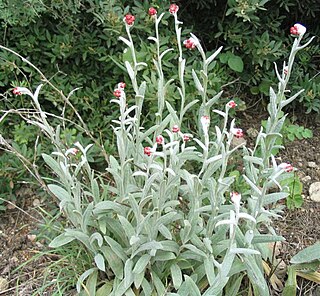
The genus Helichrysum consists of an estimated 600 species of flowering plants in the sunflower family (Asteraceae). The type species is Helichrysum orientale. They often go by the names everlasting, immortelle, and strawflower. The name is derived from the Anicent Greek words ἥλιος and χρῡσός.

Helichrysum arenarium is also known as dwarf everlast, and as immortelle.

Eublemma minutata, the scarce marbled, is a species of moth of the family Erebidae. It can be found everywhere in Europe, except for Luxembourg, the Netherlands, the northern part of Russia and various islands. In Asia, it can be found only in Lebanon.
Vulcaniella fiordalisa is a moth of the family Cosmopterigidae. It is found from Portugal and Morocco, east to the Balkan Peninsula and Lebanon.
Vulcaniella pomposella is a moth of the family Cosmopterigidae. It is found from France, the Baltic Region and Ukraine to the Mediterranean region.

Platyptilia tesseradactyla is a moth of the family Pterophoridae found in the Palearctic, and North America. It was first described by the Swedish taxonomist, Carl Linnaeus in 1761.

Coleophora caelebipennella is a moth of the family Coleophoridae. It is found in most of Europe, except Great Britain, Ireland and the Balkan Peninsula. It is also known from Pakistan.
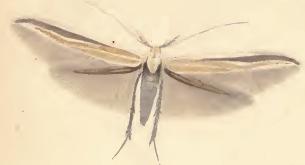
Coleophora ditella is a moth of the family Coleophoridae. It is found from Germany to the Iberian Peninsula, Italy and Bulgaria.

Coleophora gnaphalii is a moth of the family Coleophoridae. It is found from Sweden and the Baltic States to the Pyrenees, the Alps and Romania and from France to Russia.
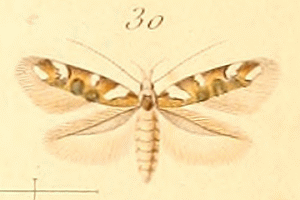
Isidiella divitella is a moth in the family Cosmopterigidae. It is found in France, on the Iberian Peninsula, Corsica and Sardinia.
Isidiella nickerlii is a moth in the family Cosmopterigidae. It is found in France, on the Iberian Peninsula and in Switzerland, Austria, Italy, the Czech Republic, Hungary, Romania and North Macedonia.
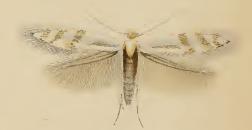
Bucculatrix gnaphaliella is a moth of the family Bucculatricidae. It is found from Sweden and the Baltic region to the Pyrenees, Italy and Romania and from France to Russia. It was described by Georg Friedrich Treitschke in 1833.

Digitivalva reticulella is a moth of the family Acrolepiidae found in most of Europe, except Ireland, Great Britain, the Netherlands, France, Portugal, Slovenia, much of the Balkan Peninsula, and Lithuania.
Scrobipalpula psilella is a moth of the family Gelechiidae. It is widely distributed throughout the Palaearctic region. It has also been recorded from North America.
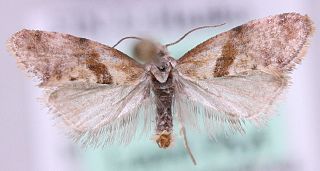
Cochylidia implicitana, the chamomile conch, is a moth of the family Tortricidae. It was described by Wocke in 1856. It is found in most of Europe, except Ireland and most of the Balkan Peninsula. Outside of Europe, it is found in Morocco, the Alatau mountains in Central Asia, Iran and China (Xinjiang). The habitat consists of waste ground and verges.
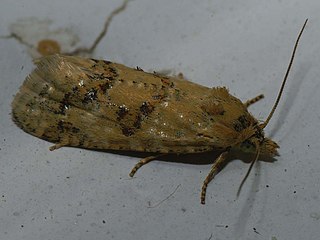
Aethes williana, the silver carrot conch, is a species of moth of the family Tortricidae. It was described by Nikolaus Joseph Brahm in 1791. It is found in most of Europe, Trans-Caspia, Asia Minor, Mongolia, north-western Africa and Iran. It is found in dry, sandy and chalky habitats.

Aethes languidana is a species of moth of the family Tortricidae. It was described by Josef Johann Mann in 1855. It is found in France, Spain, Portugal and Italy and on Corsica and Sardinia.
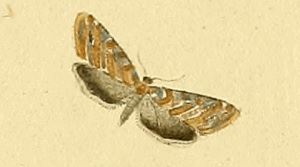
Eupoecilia cebrana is a species of moth of the family Tortricidae. It is found in Sweden, France, Germany, Denmark, Poland, Austria, Slovakia, Estonia, Latvia, Lithuania, Russia, North Macedonia and Greece.
Epiphyas oresigona is a species of moth of the family Tortricidae. It is found in Australia, where it has been recorded from Tasmania. The habitat consists of alpine heathland.
Sophronia humerella is a moth of the family Gelechiidae. It was described by Michael Denis and Ignaz Schiffermüller in 1775. It is found in Europe, North Africa and Asia Minor. The moth was removed from the British list because the records are considered unreliable.










